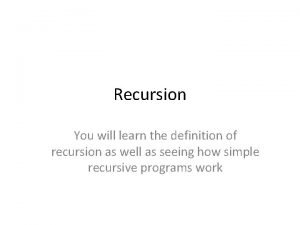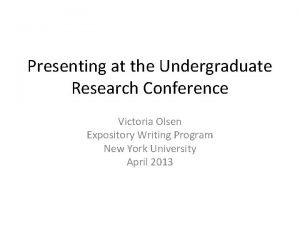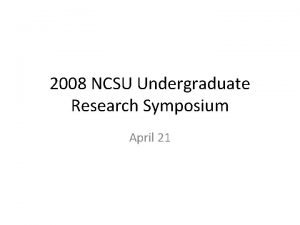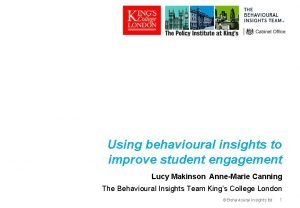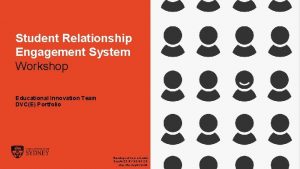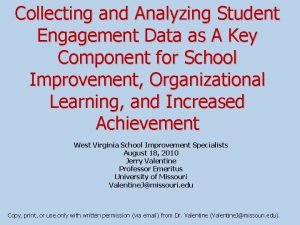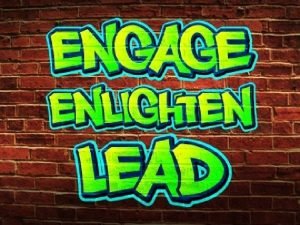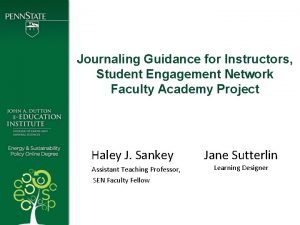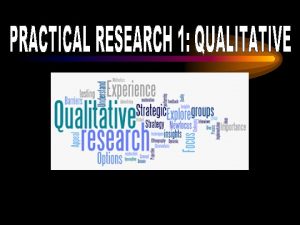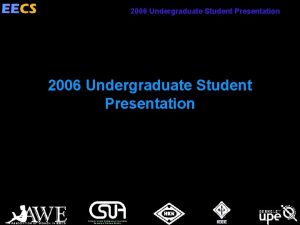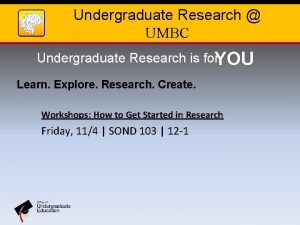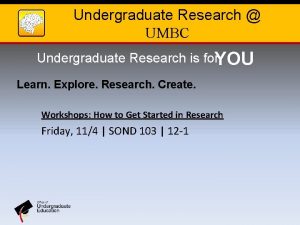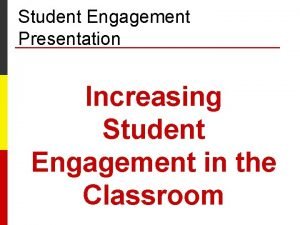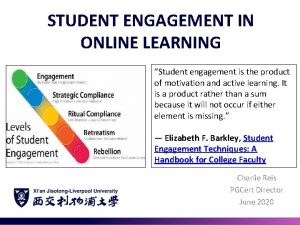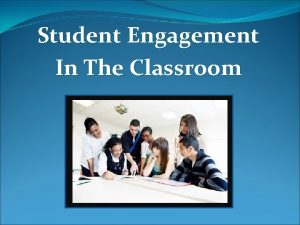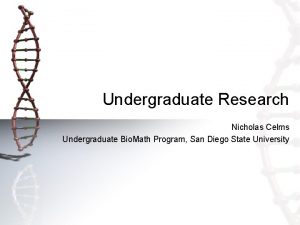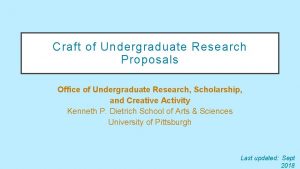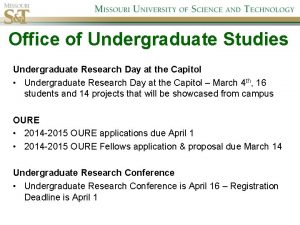EFFECTS OF UNDERGRADUATE RESEARCH EXPERIENCES ON STUDENT ENGAGEMENT
















- Slides: 16

EFFECTS OF UNDERGRADUATE RESEARCH EXPERIENCES ON STUDENT ENGAGEMENT IN STEM By Alliance Gueming Nenkam EDUC 780

WHAT IS STEM? According to White (2014), many people including some students and instructors do not know what the acronym “STEM” stands for. STEM: Science, Technology, Engineering and Mathematics.

BRIEF HISTORY OF STEM EDUCATION IN THE U. S Multiple events have converged in the creation of STEM education The Morrill Act of 1862 helped create land grant universities: initial focused on agricultural teaching, little by little added engineering based learning In 1879 when Thomas Edison invented the light bulb, STEM education was still at an embryonic stage World War II (1939 -1945) The launch of the Soviet Union’s satellite, Sputnik, in 1957 In 1957, President Eisenhower responded to Sputnik, by creating the National Aeronautics and Space Administration (NASA) 1960's President John F. Kennedy continued the promotion of scientific innovations which eventually put the first American on the moon (White, 2014)

MEN ON THE MOON A A a A

BRIEF HISTORY OF STEM EDUCATION IN THE U. S. (CONT) 1970's & 80's saw notable technological advances: cell phones and personal computers, space shuttle was launched The artificial heart made its first appearance NASA grant continues to provide STEM education initiatives to students Early 90's standards and guidelines helped establish curriculum for K-12 students in SMET later changed to STEM.

STEM education programs of high quality should include collaborative approaches to learning, connect students and educators with STEM fields and professionals Provide global and multi perspective viewpoints Incorporate strategies such as project-based learning, provide formal and informal learning experiences Incorporate appropriate technologies to enhance learning Integration of technology and engineering into science and math curriculum at a minimum Promote scientific inquiry and engineering design, include rigorous mathematics and science instruction Kelley and Knowles (2016)

Challenges to STEM Education Kelley and Knowles (2016), observed that STEM educators lack cohesive understanding of STEM education The teacher team had difficulty working together. Some had problems committing to integrated projects. (Zubrowski, 2002) Teachers struggle to make connections across the STEM disciplines (Kelley and Knowles, 2016) Students were often disinterested in science and math when they learn in an isolated manner, missing connections to crosscutting concepts and real -world applications (Kelley & Knowles, 2016). Students had problems seeing the connections between science, math, and technology, and in one situation, students resisted a multidisciplinary approach Zubrowski (2002)

Challenges to STEM Education (CONT) IT takes a huge amount of time for most students to become fully familiar with the problem to be solved, to sort out the essential elements, and to figure out how to test in a systematic way to obtain clear results (Zubrowski, 2002). Madden, et al, (2016) emphasized that the NGSS focus heavily on the interconnectedness of various content areas, Shernoff et al (2017) found that many teachers are interested in integrated approaches to STEM, but do not believe they are well prepared to implement them. We want to prepare 100, 000 new teachers in the fields of science and technology and engineering and math (Obama, White house report 2011)

Importance of STEM Education STEM activities provide hands-on and minds-on lessons for the students STEM activities provide students with critical thinking and problems solving skills and prepare them for the workforce

IMPORTANCE RESEARCH EXPERIENCES Hurtado et al (2010) reported that participation in research-oriented programs prior to college substantially increased the likelihood that URMs will aspire to a scientific research career. La. Force 1 et al (2016) explained that inclusive STEM are emerging across the country as a mechanism for improving STEM education and is important to get more diverse students into STEM majors and careers.

Experiencing Harvard Via Undergraduate Research Experiences in STEM Biomechatronics is a sub-discipline of Robotics: Biology Engineering Computer Science To create robots that help “disabled individuals”. Erika Guitierez

THEORETICAL PERSPECTIVES to examine the undergraduate research experiences of students I am planning on utilizing an integration, an involvement and an engagement lens.

INTEGRATION THEORY Tinto’s Model of student integration states that student drop out due to Academic difficulties Inability to resolve educational goals Failure to incorporate in the institution But his name remains on the honor roll as one of the three best students of the University.

INVOLVEMENT THEORY Astin’s (1984) Theory of Involvement Academic performance is correlated with the student involvement Requires an investment of psychosocial and physical energy What a student gains from being involved is directly proportional to the extent to which the student were involved Astin (1999) defines student involvement as “the amount of physical and psychological energy that the student devotes to the academic experience” (p. 518).

ENGAGEMENT THEORY Nora’s (2003) Theory of student engagement Precollege factors and pull-factors ; Sense of purpose and institutional allegiance Academic and social experiences; Cognitive and non-cognitive outcomes Goal determination; Persistence The concept of student engagement embodies factors such as the time and effort invested by the learner in school work and extracurricular activities on one hand, and the resources provided by the institution to ensure students have the opportunity to learn and benefit from their practices. (Wolf-Wendel et al, 2009). Refers to the degree of attention, curiosity, interest, optimism, and passion that students show when they are learning or being taught, which extends to the level of motivation they have to learn and progress in their education. (Wolf-Wendel et al, 2009).

References B r i e f, R. (2011). Successful K-12 STEM Education: Identifying Effective Approaches in Science, Technology, Engineering, and Mathematics. Hurtado, S. , Newman, C. B. , Tran, M. C. , & Chang, M. J. (2016). Improving the Rate of Success for Underrepresented Racial Minorities in STEM Fields: Insights from a National Project. Research. Gate, 5 -15. Kelley, T. R. , & Knowles, G. J. (2016). A conceptual framework for integrated STEM education. International Journal of STEM Education, 1 -11. doi: 10. 1186/s 40594 -016 -0046 -z Madden, L. , Beyers, J. , & O'Brien, S. (2016). The Importance of STEM Education in the Elementary Grades: Learning from Pre-service and Novice Teachers’ Perspectives. Electronic Journal of Science Education, 20(5). Shernoff, D. J. , Sinha, S. , Bressler, D. M. , & Ginsburg, L. (2017). Assessing teacher education and professional development needs for the implementation of integrated approaches to STEM education. International Journal of STEM Education. doi: 10. 1186/s 40594 -017 -0068 -1 White, D. W. (2014). What Is STEM Education and Why Is It Important? Florida Association of Teacher Educators Journal, 1(14), 1 -8. Wolf-Wendel, L. , Ward, K. , & Kinzie, J. (2009). A Tangled Web of Terms: The Overlap and Unique Contribution of Involvement, Engagement, and Integration to Understanding College Student Success. Journal of College Student Development, 50(4), 407 -428. doi: 10. 1353/csd. 0. 0077 Zubrowski, B. (2002). Integrating Science into Design Technology Projects: Using a Standard Model in the Design Process. 13(2), 47 -65. https: //www. sutori. com/story/a-history-of-stem-education https: //www. ed. gov/stem
 Uci ics academic advising
Uci ics academic advising Definition of undergraduate student
Definition of undergraduate student Undergraduate research conference nyu
Undergraduate research conference nyu Acu undergraduate research festival
Acu undergraduate research festival King's undergraduate research fellowship
King's undergraduate research fellowship Ncsu undergraduate research symposium
Ncsu undergraduate research symposium Lucy makinson
Lucy makinson Sres student portal
Sres student portal Australasian survey of student engagement
Australasian survey of student engagement Student engagement data
Student engagement data Student engagement presentation
Student engagement presentation Student engagement network
Student engagement network What are the characteristics of a good research
What are the characteristics of a good research Cosmos meaninh
Cosmos meaninh Portland state university undergraduate tuition and fees
Portland state university undergraduate tuition and fees Undergraduate graduate postgraduate
Undergraduate graduate postgraduate Difference between postgraduate and undergraduate
Difference between postgraduate and undergraduate

